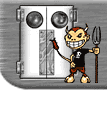





 |
 |
 |
||
 |
 |
 |
||
| |
|
|
|
|
| Home : BioPhysical Module : Online Reading 3 | ||||
The Mirror Image of Children at RiskPEPSI developed by J'Anne
Ellsworth
One of the most poignant parts of the Helen Keller story was the introduction of a teacher, Anne Sullivan, who cared about Helen, and who would not allow Helen to be less than her potential. Sullivan provided relationship, love, opened the door to "yes". When she first came to teach Helen she found a child who was unruly, wild, and unable to speak. Anne Sullivan created a way to make contact with Helen through the sense of touch. She worked out an alphabet and during the next three years developed ways to connect objects with words, then found someone to develop a Braille typewriter. Eventually she went to Radcliffe with Helen and worked as an interpreter and secretary, assisting Helen until she graduated with honors in 1904.Anne Sullivan had to define the purpose of education according to Helen's needs and expand and change the paradigm of education or fail in the effort to teach her. She went against the conventional wisdom of the day, refused, perhaps out of ignorance, to see her pupil as unteachable, or to allow the child's uniqueness, her heart, Helen's gift to humanity, to be wasted simply because there was no precedent for teaching the deaf and blind. Helen Keller, Albert Einstein, Winston Churchill and Thomas Edison are historic figures who held promise that was realized and remembered beyond their lifetimes. Each was resilient and individualistic and special. Each was considered at risk. . . yet each had personal champions who believed in the greatness of personhood. Each was provided assistance, en route, empowering the person to be true to self. Each had a protagonist or mentors who believed in the hero or heroine and counterbalanced setbacks. Someone was there to provide energy for realization of unique gifts to society and facilitate achievement of personal greatness through an unflagging dream. A society that perceives children as being "at risk" rather than "in process" is in jeopardy of missing the promise of talented and gifted youth. Many children of great potential do not match social norms or expectations (Coloroso 1994). It has been an historic model to misunderstand and vilify those who are idiosyncratic during their lifetimes, and then in absentia, immortalize them as myths or martyrs if their work succeeds.
It is crucial to revisit the forces that contribute to greatness and rethink how eminence manifests itself in youth and how it may be expressed in the process of family or therapeutic setting rather than in memoriam. We have a need to enhance insight and broaden our vision of greatness in embryo. We also have a responsibility to student and society to channel energy that reveals itself in a youngster who we believe shows the markers of being at risk. We cannot afford to misperceive valuable characteristics of personality or the sterling quality of emerging and developing will because of vaguely disquieting behavior (Glasser 1989). With our current emphasis, we are missing the promise of greatness as well as the signals of trouble from Charles Mansen, John Wayne Gacey and Jeffrey Dahmer. (How often does the media seek out an educator from a troubled adultâs past only to have the teacher review the student as a figure surrounded by shadow instead of substance and personality?) We want to be vigilant in recognizing the signals of children who are troubled, those who show signs of hurting themselves or others. Many times, however, unusual patterns of actions and behaviors,"outlier" behaviors, could be seen as interesting, thought provoking and intriguing rather than disquieting or alarming (Kohn 1990). Instead of only assigning a negative valence to the behaviors we now use to define a youngster as being at-risk, we might look to see how they presage strengths. Seeing potential and hope in uncommon behaviors (Elias & Clabby 1992) may allow us to view a youthâs persistence in maintaining responses and behaviors as more than stubbornness and discrete from dysfunction. School as one example The school setting is being used to provide examples, since virtually all readers have been involved in education. The concepts and techniques of moving the emphasis from student problems to student strengths have been successfully applied in school settings, and appear to translate well to other social settings. In most American social environments there is emphasis on competition, that is, a few who are masters, purveyors and enfranchisers of the desirable (winners, leaders, "A" students, with many who do not share in the power or glean the greater benefits by way of membership (followers, also ran. Bottom 75%). Typically , the power structure consists of a leader and followers rather than a journey of togetherness. This is not an effective environment for at-risk youngsters (Johnson and Johnson, 1994). It may not be efficient for the majority of youngsters, since it provides limited experience in becoming self empowered thinkers. The emphasis is commonly on compliance and conformity rather than creativity and individuality. One fifth of our youngsters are not completing high school (Anderson, et.al. 1985), and of those who go on to college, approximately one half do not complete that course of study (Bowman 1986). We do not know how much greatness we are missing through current practices, but we know that this represents a significant number of youth at risk. Changing the educational setting to assist youth who we see as Îat riskâ may have positive impact on all youth in the educational setting. Beliefs about the purpose of education influence the structure we develop and work to keep in place. If children as subjects to be managed, then youth who resist rules and guidelines are seen as a threat. If a child refuses to be managed, the next option that is frequently invoked is removal from the social situation (Canter, 1984). Many classrooms have wall-sized banners declaring "I have a right to teach."
This injunction endows the teacher with the right to remove children from the classroom - to the hall, the office, special education rooms, or school suspension or expulsion. If the youth attempts to manipulation the new environment, to achieve personal "needs", teachers may view it as personal infringement, perhaps as cheeky, disrespectful, a threat to stability. The youth who is being taught to be true to self and who has the freedom to do so is the person who more clearly has the potential to continue a life of education and contribute life to society. (Montouri, & Conti 1993). Integrating individual needs with group needs, the inculcation of knowledge with the personal sense of fulfillment, the need for contemplative reflection with earnest and purposive interaction in search of answers provides the cooperative integration balanced with the competitive nature of personal ãa-haä Gaining strengths from the at-risk At-risk children bring an array of attributes which can be turned to advantage. Many of the youngsters hear the pattern of self strongly (Ornstein 1993). Many have the ability to stay in an autocratic system and remain aloof and centered on a different perceptual reality. Many have a strength of will that is unshakable. In the face of adversity, they can cling with incredible strength and determination to an inner voice of resolve. Many are resilient, having braved incredible personal assaults, yet continue to hold to a kernel of unshakable faith in self, a hope for a bright future, a will to live and contribute. In these young people who still hold hope, we can find unique and creative coping mechanisms, survival skills, strength of will and indomitable character. Unfortunately, these wonderful personal gifts and social tools are often lost in the few aberrant patterns of self preservation that are most apparent to observers. As Frances Thompson (1961) wrote, " ... none but I makes much of naught" (He said), and human love needs human meriting: How hast thou merited -- Of all manâs clotted clay the dingiest clot. " If we could view those "at risk" youngsters with a different lens, cast a more kindly light on their likeness, eke out the hidden grace and courage, these strengths could be shared, and what a wealth of character we would bequeath to others in the learning community (Froyen 1993).
1) Look for and enumerate strengths in one another rather than weaknesses, 2) Ask each youth what gift he or she has to give, then listen with the ear of possibilities and facilitate the dreams, much as did Anne Sullivan, 3) Find ways to build community wherever children are gathered, focusing on cooperation and acceptance rather than on differences and inequity 4) Use that community focus as a springboard to facilitate every participant gaining insights about one another, 5) Help youthful peers view each other as referents possessing positive traits and the strength to make the hard choices, 6) Examine and adopt a different way of looking at human nature, 7) Listen to and encourage self observed strengths and accomplishments, 8) View failed attempts as proof of effort and the desire to succeed, as a step up on the ladder of success - "practice makes perfect." Using light as a metaphor, we might glimpse new possibilities and pleasures in one another if we were able to see children as points of light, much like on a Christmas tree. The strings of lights on a tree frequently combine to only four of five hundred watts of light, yet how endearing the sparkle of those myriad twinkles rather than one overhead fixture. Collect
a
Works Cited
Once you have completed this topic you should: Go on to
Assignment 1
|
||||
| E-mail J'Anne Ellsworth at Janne.Ellsworth@nau.edu | ||||
|
Course Created by J'Anne Ellsworth & Center for Technology Enhanced Learning Copyright
© 2001 Northern Arizona University |
 |
 |
 |
 |
 |
|